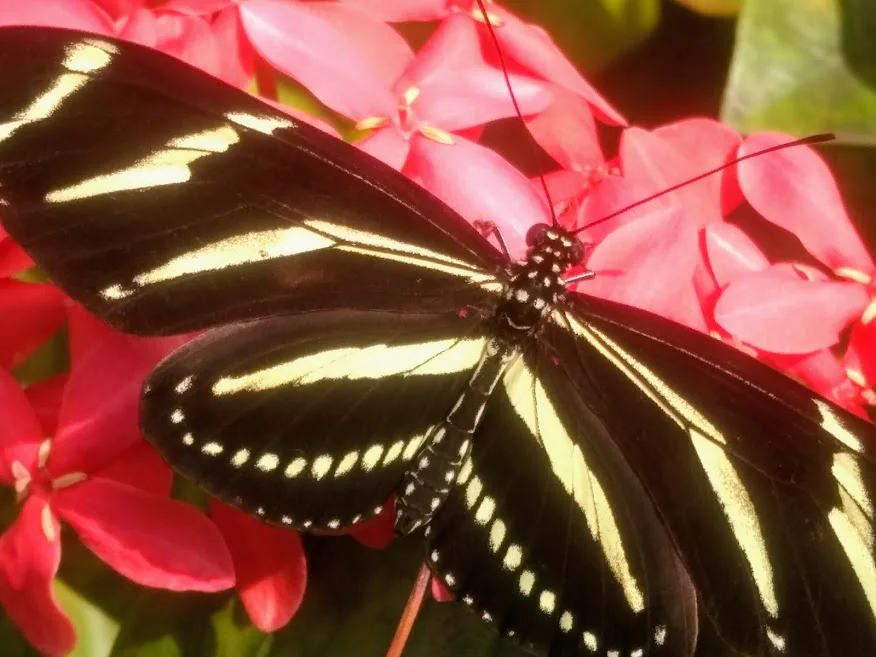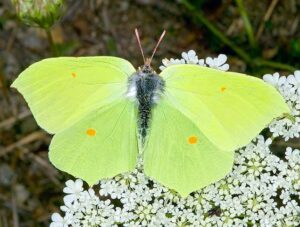
Zebra Longwing Butterfly
The caterpillars are white with black spots and have numerous black spikes along their body. Adult butterflies are monomorphic of medium size with long wings. On the dorsal side, the wings are black with narrow white and yellow stripes, with a similar pattern on the ventral side, but paler and with red spots.
The wingspan ranges from 72 to 100 mm.
Did you know?
Adults roost in groups of up to 60 individuals on a nightly basis, returning to the same roost every night.
common name: zebra longwing
scientific name: Heliconius charithonia (Linnaeus) (Insecta: Lepidoptera: Nymphalidae)
The zebra longwing, Heliconius charithonia (Linnaeus), was designated the state butterfly of Florida in 1996. A denizen of more forested settings, it frequents subtropical hammocks, forest margins, shrubby thickets, and adjacent open areas. It is a regular sight in many butterfly gardens and suburban yards and parks.
The zebra longwing is a neotropical butterfly that occurs in extreme southern portions of the United States southward through Mexico, Central America and the West Indies to South America. Adults occasionally wander northward. It is locally common throughout peninsular Florida.
Adults: Zebra longwings are medium-sized butterflies with elongated wings. They cannot be confused with any other Florida butterfly. Adults have a wingspan range of 72 to 100 mm. The sexes are similar. The upper surface of the wings is black with several bold, narrow yellow stripes. The wings below have a similar pattern, but are paler in color and have several small red spots near the body.

Eggs: The yellow eggs are laid singly or in small clusters on new growth of the host plant.

Larvae: The mature larvae are white with black spots numerous black branched spines.


Life Cycle
The zebra longwing produces multiple generations each year. Adults may be found in all months of the year throughout much of central and southern portions of Florida. Adults have slow, relaxed flight. Females lay the small yellow eggs singly or in small clusters on terminal leaves and trendrils of the host plants.
Adult zebra longwing butterflies feed on both flower nectar and pollen. The additional nutrients from the pollen enable individuals to survive for several months, far exceeding the normal two to four week adult life span of most other butterflies. Adult individuals often form small communal roosts at night.
The zebra longwing butterfly begins mating right after it emerges from its chrysalis. The female lays five to fifteen eggs on the leaves of passion flower vines. The caterpillar has a white body with long black spines and a yellow head. If weather conditions are right, the zebra longwing butterfly can go from egg to butterfly in a little over three weeks.
Hosts
Common hosts are purple passionflower, Passiflora incarnata L.; corkystem passionflower, Passiflora suberosa L.; yellow passionflower Passiflora lutea L.; and several other passionflower vines.
Zebra Longwing Butterfly (Heliconius charithonia)
The zebra longwing butterfly or zebra heliconian, Heliconius charithonia, is unmistakable with its long narrow wings, which are striped black and pale yellow. This species is common in Mexico and Central America and it is also found in most of Florida and in some areas of Texas, where it can be seen year round. Occasionally it wanders farther north as far as South Carolina and some of the central states, although it is not likely to survive the cold. Florida designated this striking creature as its state butterfly in 1996.
They fly slowly and gracefully and are not easily startled. They gather in roosts to spend the night returning to the same place daily; all this making it easy to observe them. After mating the female lays eggs on one of several species of passion flower plants Passiflora. The caterpillars feed on these plants and acquire some of their toxins; this makes them distasteful to predators. The striking colors and pattern of the adults advertise their toxicity.
An unusual feature of the longwing, or heliconian, butterflies is that the adults are relatively long lived. Most other butterflies live only a few weeks, but heliconians continue to live and to lay eggs for several months. Their tropical or semitropical habitat makes this possible; furthermore the feeding habits of the adults are important in prolonging their lives. The adults feed on nectar of flowers, like most other butterflies, but a special characteristic of heliconian butterflies is that they can also feed on pollen.
Most butterflies can only sip fluids with their specialized mouth parts, but the heliconian butterflies take some pollen as well as nectar. Their saliva enables them to dissolve the pollen and to take their nutrients. Pollen is very nutritious, rich in proteins, unlike nectar which contains almost no proteins, just sugars. This diet allows the butterflies to prolong their lives and also enables them to continue producing eggs for several months. As a consequence they are more dependent on flowers than other types of butterflies and this makes them good pollinators. They feed on a wide range of flowers; some of their favorites are lantana (Lantana, Verbenaceae family) and shepherd’s needle (Bidens pilosa, Asteraceae family). It is also possible that they develop a sort of symbiosis with those plants that provide their preferred pollen.
Zebra longwing and other heliconians have a reputation for being very intelligent insects. They have a social order when roosting; the oldest ones choose the best places. They also gently nudge the others early in the morning to get going. Another interesting characteristic of heliconian butterflies is that they can remember their food sources and return daily to the plants where they fed previously, a behavior known as trap lining. The memory is so strong that if one shrub in their route is cut down they return to the location again and again only to search in vain.
A relative of this butterfly, the Red Postman (Heliconius erato), is seen occasionally in Texas. It is also very beautiful, black with white and red markings. Its life style is similar to that of the zebra longwing.
Heliconius charithonia, the zebra longwing or zebra heliconian, is a species of butterfly belonging to the subfamily Heliconiinae of the family Nymphalidae.It was first described by Carl Linnaeus in his 1767 12th edition of Systema Naturae. The boldly striped black and white wing pattern is aposematic, warning off predators. It is the state butterfly of Florida.
The species is distributed across South and Central America and as far north as southern Texas and peninsular Florida; there are migrations north into other American states in the warmer months.
Zebra longwing adults roost communally at night in groups of up to 60 adults for safety from predators. The adult butterflies are unusual in feeding on pollen as well as on nectar; the pollen enables them to synthesize cyanogenic glycosides that make their bodies toxic to potential predators. Caterpillars feed on various species of passionflower, evading the plants’ defensive trichomes by biting them off or laying silk mats over them.
The zebra longwing, Heliconius charithonia (Linnaeus),was designated the state butterfly of Florida in 1996. However, mass spraying of naled has decimated the zebra longwing population in Miami-Dade County, Florida. There has been mass collapse of the colonies with impacts on the balance of the ecosystem. Further studies are needed to evaluate any potential for recolonization.


Life History: Males patrol for females, and are also attracted to female chrysalids. A male will wait on the chrysalis and mate with the female as she is about to emerge. He then deposits on her abdomen a chemical than repels other males. Eggs are laid in groups of 5-15 on leaf buds or leaves of the host plant; caterpillars feed at night on leaves. Adults roost communally in groups of 25-30 individuals.
Flight: All year in South Texas and southern Florida, wanders north during warmer months.
Caterpillar Hosts: Passion-vines including Passiflora suberosa, P. lutea, and P. affinis.
Adult Food: Flower nectar and pollen, which are gathered on a set foraging route or “trap-line”. Favorite plants include lantana and shepherd’s needle.
Habitat: Tropical hammocks, moist forests, edges, fields.The zebra longwing butterfly lives in warm, damp tropical areas. It is often found in hammocks and thickets.
Range: South America north through Central America, West Indies, and Mexico to South Texas and peninsular Florida. Occasional immigrant north to New Mexico, Nebraska, and South Carolina.
Conservation: Not usually required, but habitat for permanent populations is limited in South Texas.
Not only do they love the flowers, but it seems the flowers make them fall in love. Well, no, not love. But they sure do start mating a lot on and around the plants. It must bloom at some peak of their multigenerational northward migration. Like they did in September of last year, they mated, and mated some more, and the resulting caterpillars ate our milkweed plants down to their stems.
I feel like I’ve seen more death in my yard this year than in other years, but that’s because there’s so much more life in my yard than in other years. I simply have way more wildflowers and other native plants than I’ve ever had. If you don’t want to see dead butterflies and caterpillars, don’t plant any wildflowers or larval food plants.
I’ve seen people get discouraged because they don’t see many caterpillars make it to adulthood in their yards. The thing is, you’ve created a space for them that otherwise wouldn’t exist in an urban/ suburban setting. We see up years and we see down years, but we can’t get hung up on how many caterpillars we see make it or not make it in a given year. If more of us create a backyard habitat, there are more places where a butterfly can lay its eggs. This makes the species, and the insect population in your area overall, more resilient.


